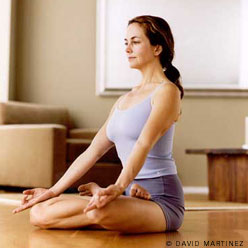Steve (featured in an earlier post), one of my students, asked me if he couldn't get the depth he wanted to in a pose, even though he practiced a lot and worked at it almost daily, what did he have to do to get into the ideal (from his perspective) pose. Knowing Steve pretty well, and knowing that he practices almost daily, I offered this response.
When we begin to practice yoga, many of us fall in love with it, enjoy the way it makes us feel, and want to improve so much that we commit a lot of time and effort to getting better and better at it. We may take lots of classes from many different teachers. Sometimes part of our motivation is to find the "secret ingredient" that makes our poses perfect. This is a wonderful way to begin our yoga journey. (Any reason to begin is the right reason).
The trouble is, all of this effort results in a tremendous amount of striving. This very striving becomes a major distraction. When we're trying so hard, sometimes we overdo and get burned out, discouraged, or injure ourselves. We have difficulty accepting the fact that we're not perfect, and we are unable to be happy with where we are.
In the Eightfold Path (ashtanga) spoken of in Patanjali's Yoga Sutras, principle number five is called "pratyahara". I quote Yoga Journal here:
Pratyahara, the fifth limb, means withdrawal or sensory transcendence.
It is during this stage that we make the conscious effort to draw our
awareness away from the external world and outside stimuli (distractions). Keenly aware
of, yet cultivating a detachment from, our senses, we direct our
attention internally. The practice of pratyahara provides us with an
opportunity to step back and take a look at ourselves. This withdrawal
allows us to objectively observe our cravings: habits that are perhaps
detrimental to our health and which likely interfere with our inner
growth.
I explained to Steve that once you get into the pose (the active/striving/effort-ful part of the pose) we withdraw from the active effort and begin to yield effortlessly into the pose. Here we turn our attention inward, observing the inner landscape of the body, rather than the structural mechanics of the outward posture. When we begin to relax into, or yield into the pose, our body finds wholeness, stability, and a measure of restfulness or effortlessness.
At this point, there becomes a balance between effort and effortless, or activity and yielding. This balance is pratyahara, wherein the mind/body/awareness lets go of the striving and becomes one with the pose. The senses are withdrawn from the exterior and become one with the interior feeling tone of the posture.
Sometimes when this balance is attained, when the body begins to yield, it will go deeper into the pose. This new objective awareness makes it clear that where we are is perfect right now. This opens up a whole new level of depth in our practice. The result of active yield or effortless effort is the integration of the body, the mind, and the spirit. This is often defined by a very blissful feeling. This is when we truly start to experience yoga.




